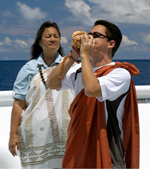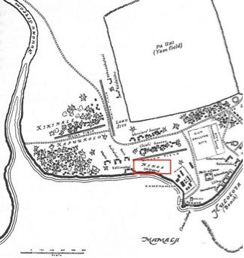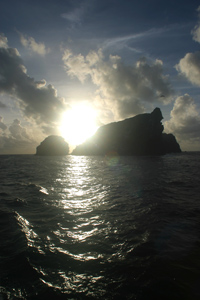
What is the importance of names?
In Hawaiian culture, as in other cultures, names convey a wide range of information and express varying levels of meaning. Names can be given to remember historic events, ancestors, geographical features, and moʻolelo (stories/histories). Also, a particular person, place, or thing may have several different names to represent its different aspects. Here we look at the various ways of naming, the variety of names given, and how names are integral to our work at Papahānaumokuākea.

Kekuewa Kikiloi blowing the pū (conch shell). Credit: David Boynton |
One's genealogy is extremely important and a critical aspect of one's identity. Since Hawaiian is a spoken language, genealogies were memorized at an early age and were passed down orally through the generations. The highest of aliʻi (chiefs) could trace their lineage directly back to the beginning of the universe. Because of the high value placed on intergenerational connections and honoring of ancestors, inoa kupuna (ancestral names) are commonplace throughout Hawaiʻi. Often, children will either be given an ancestor's name verbatim or the names of various ancestors will be incorporated into the child's name to honor many ancestors that are hoped to contribute in some way to the child's well-being. |

This map by Paul Rockwood as described by John Papa ʻIʻi illustrates the area known as Honolulu Harbor. The area right above the shipyard (boxed in red) is labeled as Nihoa. |
Hawaiian history is full of people and events that are remembered in different ways including mele (chant), hula (dance), moʻolelo, and inoa (names). A name given to a person or place to commemorate a certain event or to honor a certain chief was called an inoa hoʻomanaʻo. Literally translated, inoa hoʻomanaʻo means "remembering name." Travelling was very prominent among aliʻi to explore the world and establish overseas connections with other countries. For example, in remembrance of Queen Kaʻahumanu's voyage to Nihoa in 1822, some of the children of those who accompanied her were given the name Nihoa. To this day the name Nihoa is still remembered and perpetuated by the descendants of the members aboard the original voyage with Kaʻahumanu. Also, the queen was so moved by her trip that, when she returned to Oʻahu, she named some of her Oʻahu lands Nihoa, including the house in which she resided in. |

Mokumanamana. Credit: James Watt |
A strong sense of place is a prominent theme throughout the Hawaiian culture. The islands of Hawaiʻi, being the earliest ancestors of the Hawaiian people, were cared for in the same manner as one would for an elder, with great respect and care. Subsequently, inoa ʻāina, place names, were held in equally high regard. Often times inoa ʻāina act as inoa hoʻomanaʻo in the sense that the names are given to memorialize a certain chief or deity in Hawaiian or to remember important events from among the countless moʻolelo that are told. Other inoa ʻāina give insight into environmental features of the area such as climate, topography, or vegetation. Nihoa, meaning toothed or jagged, is one such inoa ʻāina. It clearly paints a picture of the jagged, unstable terrain that makes up this island. The geographical features of Papahānaumokuākea have more recently been given names, however there are ancient names for those places scattered throughout mele and mo'olelo that have yet to be uncovered. |
Inoa kupuna, inoa hoʻomanaʻo, and inoa ʻāina are just a few naming practices prominent in Hawaiian culture and history. Every name was deliberate and thought out. Names can be useful, intuitive, informative, and beautiful when delving into the many layers of meaning that can make up a name. The names of the atolls, reefs, and islands that make up Papahānaumokuākea are like pieces of a puzzle made by our kūpuna and it is our job to put those pieces together and reveal the knowledge that lies within those names.
